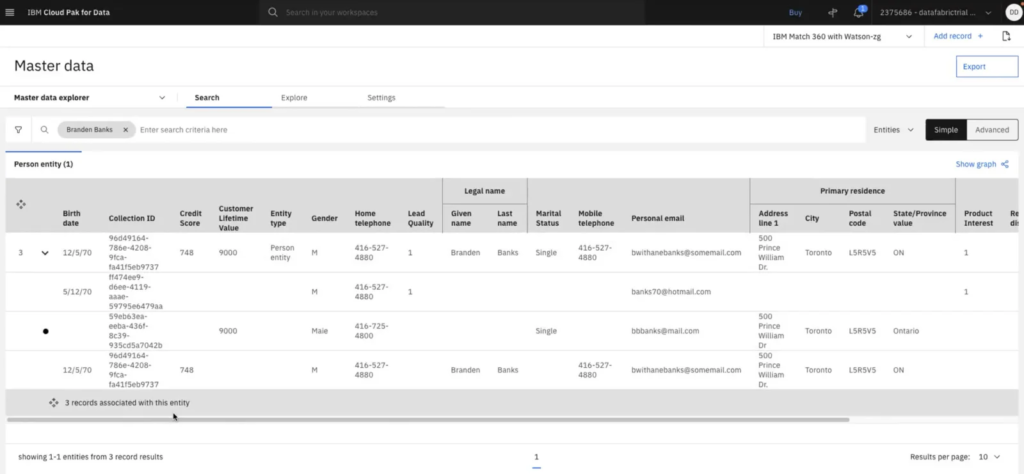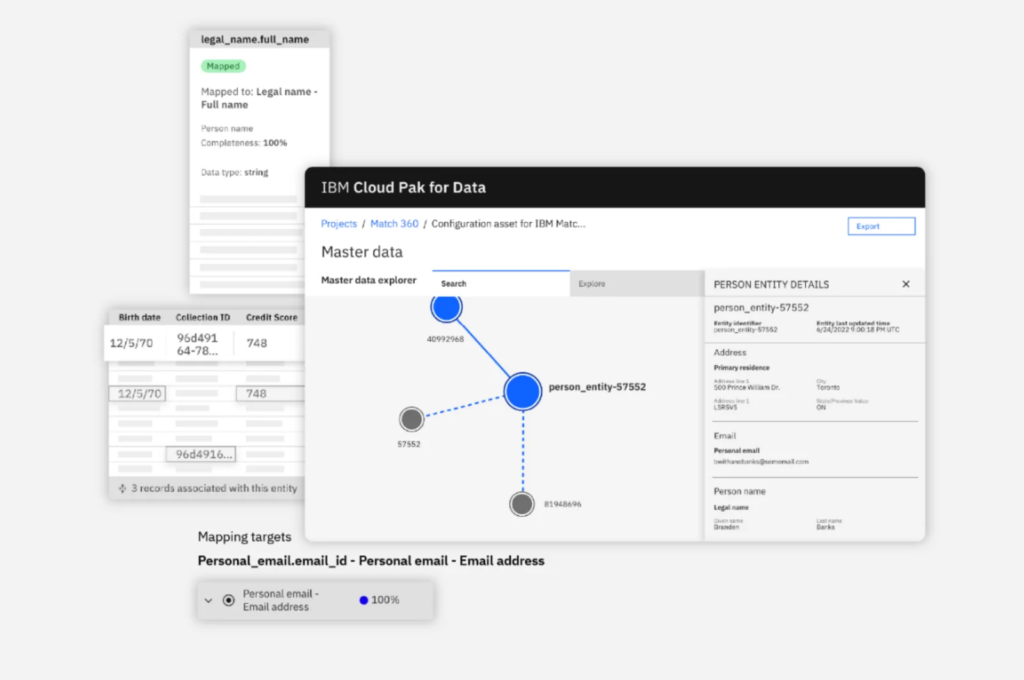IBM Master Data Management
Update solution on March 27, 2025


Fig 1 – Conduct your work with speed and ease within one platform
IBM has had a family of products that tackle various aspects of master data management (MDM) for many years. Their flagship offering in recent times has been IBM InfoSphere Master Data Management, but they also have IBM Product Master and the related IBM Knowledge Catalog, the Manta Data Lineage tool, and IBM Identity Insight and Global name Management. In December 2024 announced the future direction of its MDM technology in the form of IBM Match 360. This is a cloud-native, multi-domain product that uses as its hub the graph database Neo4J and is designed to support modern data architectures such as data fabric and data mesh within the IBM Cloud Pak for Data platform, as well as more traditional architectures. A data model is configured covering entities, attributes and record types, and samples of data can be ingested via either an extract/transform/load process or the data virtualization/Watson query service. Data can be profiled and data quality analysis carried out, with Match 360 using matching algorithms to resolve data records into master data entities. The software itself suggests the attributes for matching the entity types, and has a range of standardization options out of the box, such as phonetics, synonyms, concatenation, transposition and many more. Pair analysis review provides an automated approach to tuning the matching algorithms based on machine learning. The product can automatically link records that meet a certain threshold of matching score, and refer borderline cases for human review.

Fig 2 – Deliver consolidated governed views of critical enterprise data through intelligent data matching
The product’s interface allows users to explore and search for business entities, as well as to match data from multiple sources using its AI-driven matching engine. The product supports the application of privacy rules, for example, the masking of sensitive data. Data quality rules can be applied too in order to ensure that the data is accurate, timely and complete. Once held within the master data hub, the data can be provided to other applications and business consumers that can use the data for their analytics, reporting or data science needs.
Recent new functionality includes the ability to permanently store composite views in the graph database and improved navigation, while a multi-year roadmap of additional functionality has been set out by IBM. The other IBM products in the master data management space will continue to be enhanced, but they will gradually merge and be subsumed within the Match 360 product.
Enterprises that are implementing generative AI applications based on large language models (LLMs) have quickly realised that, in order for applications such as customer service chatbots to be effective, they need to understand company-specific information. A chatbot needs to be aware of customer order history, and be familiar with the details of the products that a customer is referring to, but of course a public LLM such as ChatGPT or Claude Sonnet has no such information by default. So a process called retrieval augmented generation (RAG) is needed, which involves taking company datasets such as product manuals and customer information and supplementing the raw LLM with this additional information. For this to happen, the data needs to be in the form that an LLM can understand, via a vector search or a specialist vector database. However, such an approach relies on the company-specific data used to be trustworthy and of high quality, as the LLM’s answers will reflect the quality of the data that it is trained on. This is where Match 360 can help, since it has support for consolidated, trustworthy records that have been through a data quality process.
The bottom line
IBM has had a disparate set of solutions in the master data management space for some years, and while these have been effective, with many hundreds of customers, such a complex portfolio has been potentially confusing. Consolidating these various tools and subsuming them into a modern, cloud-based product makes sense, and will reassure existing customers that there is a viable path forward. IBM needs to communicate its roadmap to its customers and ensure that there is a smooth migration path from its current offerings to its new flagship MDM offering.
Related Company
Connect with Us
Ready to Get Started
Learn how Bloor Research can support your organization’s journey toward a smarter, more secure future."
Connect with us Join Our Community
